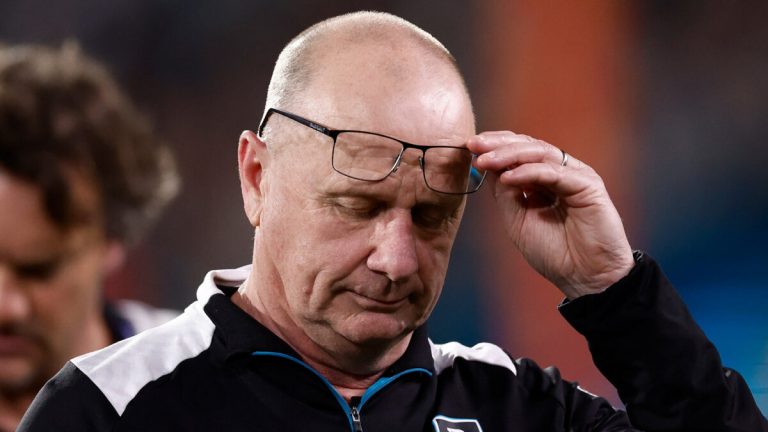The NHL trade deadline was three months ago, but as the Stanley Cup Final gets set to begin this week and all eyes are on what should be an excellent series, trade talk is once again picking up around the league. That’s because 30 NHL teams that are no longer in the running are discussing ways to improve their rosters for the 2025-26 season.
Several possible trades are being discussed among management teams and so, in my first off-season trade board, I’ll give you some insight into how I think things might begin to unfold going into the draft, free agency, and beyond.
This week, the NHL Combine is taking place in Buffalo and will be the last time every team is together under the same roof because the NHL Draft will be a decentralized, virtual event from June 27-28. What that means for the trade market in terms of when deals get done remains to be seen, but as one NHL GM explained, more freely talking about deals at the week-long combine could initiate trade talks more than before since the follow-up, in-person meetings that usually occur at the draft won’t be happening this year.

-
Real Kyper and Bourne
Nick Kypreos and Justin Bourne talk all things hockey with some of the biggest names in the game. Watch live every weekday on Sportsnet and Sportsnet+ — or listen live on Sportsnet 590 The FAN — from 3 p.m. to 4 p.m. ET.
The draft has always been a big event for trades. For example, the Tampa-Utah trade involving Mikhail Sergachev last year happened after a discussion on the draft floor. Trades are still likely to be finalized during draft weekend this year, it’s just that there could be plenty more buzz coming out of the combine this time.
Although the 2024-25 NHL season isn’t over yet, trades that impact next season could heat up in just a matter of days, whether they are finalized sooner, or still taken across the finish line at the draft.
Soon, only one team will be able to claim they got everything right about their roster and walk into the summer months as champions. For the rest, the work begins on finding just the right mix and making the correct calls to ensure they come back better next fall.
So now, on to my latest list of players to watch in trade talks over the next several weeks.

It’s a huge off-season for the Canucks, and one of their biggest situations to consider is with Elias Pettersson. In the first year of an eight-year contract paying $11.6 million against the salary cap, Pettersson recorded only 15 goals and 45 points in 64 games and questions arose about his conditioning and how prepared he was for the season when camp opened last fall.
Pettersson doesn’t have any trade protection in his contract for now, but that changes on July 1 when a full no-movement clause kicks in. Are the Canucks prepared to keep Pettersson and hope he rebounds to being a 100-point player? Or will they look to move him over the next month before that clause kicks in? Despite a down season for Pettersson, his value hasn’t taken as big of a hit as many perceive.

There is change coming to the Leafs’ core after the group failed yet again to get past the second round and ended on such a sour note in Game 7’s 6-1 loss. But how deep will those changes go? Mitch Marner and John Tavares are pending UFAs, and if one or both of them leav,e it’s unlikely Toronto would consider other monumental changes, like exploring an Auston Matthews trade. However, the one player it does make sense to explore trading is Morgan Rielly.
Rielly is not on this list because anything is imminent or guaranteed to happen, but he is the logical first place the Leafs could look if they want to make deeper changes to the roster. The Leafs want to add another puck-moving, skating defenceman regardless of whether Rielly stays or goes. How high level of a defenceman they will add may depend on their ability to move Reilly’s contract.
I believe the team will, at some point, begin exploring their options on what to do with Rielly. His contract — five more years, $7.5 million AAV — is not as onerous as Matthews’ or William Nylander’s, which would be extremely complicated trades to pull off. Rielly, 31, does have a full no-movement clause and hasn’t made an indication he’s willing to waive, so there would need to be a mutual understanding that a change of scenery is in everybody’s best interests. I’d start with a team near his hometown like the Canucks.

The Flames put up a heck of a fight all season to stay in the playoff race, but the fact is the focus is on the future in this market, and GM Craig Conroy must manage his roster with that big picture in mind. Rasmus Andersson is a terrific defender, a Team Sweden mainstay, but he’ll turn 29 shortly after the next NHL season begins and is entering the final year of his contract with the Flames.
Eric Francis wrote that Andersson’s season-end media availability “certainly felt like a farewell press conference,” and Calgary could very well look to move out Andersson over the summer months. There’s a belief that Brad Treliving had interest in bringing Andersson to Toronto at the 2025 trade deadline: could that be re-examined, and could Rielly be involved?

Trade speculation around Karlsson is nothing new, even after he was already moved once under this contract from San Jose to Pittsburgh. The Penguins are just not a fit for Karlsson anymore as GM Kyle Dubas tries to find younger players and more picks to rebuild the Penguins on the fly while Sidney Crosby is still around. What makes a Karlsson trade perhaps more likely this summer is that he only has two years remaining on his contract and, after Pittsburgh pays him a $5 million signing bonus on July 1, the defenceman will only be owed $11.5 million in real dollars.
Pittsburgh might have to retain some of Karlsson’s $10 million AAV on their books (San Jose has retained $1.5 million from the original AAV) and would absolutely do so if it helps them get back what they want. The fact Seth Jones was traded to Florida this season and has shown everyone that he still has tremendous on-ice value in the right circumstance will help the Penguins. Dubas will be pitching Karlsson in the same manner.

After scoring a career high 24 goals and 60 points, by the time the playoffs rolled around, Marco Rossi was on Minnesota’s fourth line. The top order of business for Minnesota this summer is to figure out a contract with Kirill Kaprizov, still one year away from being eligible for unrestricted free agency but able to sign an extension as of July 1. But they also have to figure out what an extension will look like for Rossi, who will become an RFA this summer and potentially the target for an offer sheet if negotiations linger too long. The Wild could use this time to trade Rossi, who holds a lot of value as a centre with rising production and who turns just 24 in September.

The key piece in the first Mikko Rantanen trade this season, Martin Necas largely delivered on what was promised — he was just shy of being a point-per-game player in the regular season and found a home on Colorado’s top line. But before that trade, Necas only signed a short-term deal with Carolina when the two sides couldn’t agree on his long-term value, meaning he has one season left making $6.5 million against the cap, after which he could test the waters as a UFA.
After the Avalanche moved Rantanen because of how difficult they perceived contract extension talks to be going, how much patience will they have with Necas — not a homegrown player or superstar talent — if negotiations on an extension start slowly this July? There was a sense Necas wasn’t overly thrilled with his experience in Colorado and that he wants to explore other options.

Another name that has been in the rumour mill for years, John Gibson is back yet again, but, like Karlsson, there are a growing number of reasons why it might finally make sense to find a trade partner this summer. For one, 24-year-old Lukas Dostal stepped up for the Ducks and had a great regular season, playing 54 games, posting a .903 save percentage, and the 15th-best Goals Saved Above Expected Per 60 Minutes among NHL goalies (minimum 30 games played). Gibson also played well in 29 games, with a .912 save percentage that was his best mark since 2018-19.
Gibson will turn 32 over the summer and has two years left on his contract making $6.4 million against the cap. There are not a lot of proven netminders available in free agency this summer, so if a team is looking for an upgrade or someone who could take the lead in a tandem, trading for Gibson may be their best bet.

The Rangers’ season first started running off the rails after rumours leaked that the team was looking around the league at the possibility of trading then-captain Jacob Trouba, and long-time Ranger Chris Kreider. While Trouba was moved in-season, Kreider stayed put, but will now be in the rumour mill all summer as GM Chris Drury considers huge changes to a roster that fell well below expectations and is facing a relative cap crunch compared to most of the league.
New York has $8.42 million in off-season cap room, fourth-least in the NHL, without factoring in extensions for any of their RFAs (K’Andre Miller and Will Cuylle the most notable). Kreider, 34, will make $6.5 million against the cap for another two seasons and has a 15-team no-trade list. He may not have put up the best offensive season of his career despite scoring 22 goals (he had only eight assists), but Kreider can still move well and kill penalties. Trading him out, even if it means retaining money, might be one of the better ways for Drury to come up with more space.

GM Kevyn Adams is still running the show and made one substantial in-season move when he swapped Dylan Cozens with Josh Norris in a trade with Ottawa. But after yet another crushingly disappointing season in which the rebuild did not take a step forward, Adams should be exploring more changes.
On the back end, Buffalo has Rasmus Dahlin ($11 million), Owen Power ($8.35 million) and Mattias Samuelsson ($4.285 million) all signed to long-term deals. Meanwhile, Bowen Byram is an RFA this summer, just two years away from being eligible for unrestricted free agency, meaning he could look to slow walk a contract to UFA at age 25. He could also be a target for an offer sheet.
If his number is around $7 million, the question has to be asked if the Sabres are simply putting too much money into a blue line that has not helped the team break through and if, instead, the best play is to move someone like Byram – a 23-year-old coming off a career-best offensive season – if it helps them improve the overall roster.

Missing the playoffs for a second year in a row – and for the third time in their four seasons of existence – the Kraken will be looking to make changes this summer and Jamie Oleksiak would be a target for many teams. Here you have a 6-foot-7, 252-pound blueliner who led all Seattle players in blocked shots and was one of the team’s most utilized players on the penalty kill. Kraken GM Ron Francis considered moving Oleksiak at points during the 2024-25 season, but ultimately kept the player. Now, Oleksiak will be entering the final year of his contract, making $4.6 million against the cap, which is really good value for any potential buyer.

The Rangers have much to consider this summer and are exploring several options, one of which is getting a feel of the market for K’Andre Miller. The 25-year-old defenceman is an RFA this summer and the Rangers have a decision to make: sign him to a bridge contract that walks him to unrestricted free agency, work out a long-term extension to lock him in as a core piece of the roster, or possibly move him to shake up the team. Even though 2024-25 wasn’t Miller’s strongest campaign yet, he still oozes potential, plays key PK minutes and averaged more even-strength ice time than any other Ranger.

An RFA with arbitration rights and just one year away from being eligible for unrestricted free agency, 26-year-old defenceman Nicolas Hague is looking for big money on his next deal. Since Vegas has already committed a lot of money to Alex Pietrangelo, Shea Theodore and Noah Hanifin on the back end, Hague appears to be the odd man out at this time.
The Golden Knights also have some prospect options whom they could look at to make the full-time jump to the roster next season. Hague could be an interesting sign-and-trade player and will certainly garner a lot of interest around the league.

Losing in Round 2 to Edmonton this season after failing to get out of Round 1 in 2024 has the Golden Knights thinking of ways they can come back better. We know this is a team that can get very active on the trade market. They want to create cap space and perhaps chase some of the bigger free agents this summer, such as Mitch Marner.
So, Ivan Barbashev is considered one of their most movable pieces, a 23-goal, 51-point scorer this season who’s making $5 million against the salary cap for another three years. The 29-year-old would be an interesting target for teams that are looking to bolster their offence, such as Ottawa or Carolina. Barbashev does have an eight-team no-trade list.

A fixture on my trade board throughout the regular season, the Flyers knew they didn’t have to rush into a move involving defenceman Rasmus Ristolainen, who still has another two years remaining on his contract with a $5.1 million cap hit. Big, right-shot and physical defencemen are popular pieces to add and Ristolainen is coming off a bounce-back season. He’ll turn 31 in October and the Flyers will again explore the market for him over these next few weeks before the draft and into the summer if no deal is found before then.

At points this season, Justin Faulk had appeared on my trade board because the Blues were trailing the playoff race and seemed to be exploring several trade possibilities. When they shot back up into the race the calculation changed. This off-season, Faulk again will be a trade candidate as Doug Armstrong looks at ways to improve St. Louis’ roster for 2025-26 and set them up for future success as best he can before handing the GM reins over to Alexander Steen.
Faulk is 33, played in all situations for St. Louis this season, and though he makes $6.5 million against the cap, he’s owed just $4.5 million in actual salary in both of the last two years of his deal. The other wrinkle is that while Faulk had a full no-trade clause through 2024-25 in his contract that changes to a 15-team no-trade list this summer.

When Andrew Copp signed a five-year contract with Detroit as a UFA in 2022, he was coming off a 21-goal, 53-point season between Winnipeg and New York and was expected to be a solid addition down the middle to round out the Red Wings’ centre depth. However, he hasn’t been able to replicate those offensive totals since, finishing with 10 goals and 23 points this season.
He’s declined over his first three seasons with the Red Wings and now GM Steve Yzerman will be exploring options. Copp has a 10-team no-trade list and his $5.625 million cap hit is a lot for what he’s currently bringing in on-ice value, so Yzerman could look to retain a lot of money here to maximize the return and aim to get something similar to what Philadelphia did for Scott Laughton (a first-round pick).

The Chicago Blackhawks are going to continue focusing on the prospects they have coming up through their system and ensure that those who are ready will have an opportunity to grab a place on the NHL roster, which makes someone like Connor Murphy very expendable. The 32-year-old defenceman has one year remaining on his contract and a $4.4 million cap hit the Blackhawks could even retain some of — Seth Jones is currently the only player they’ve used salary retention for. Murphy averaged 20:37 of ice time this season and was used on the penalty kill.

After being traded from Tampa Bay to Nashville in 2022 and then back to the Lightning in 2024, 35-year-old defenceman Ryan McDonagh may be on the move again this summer. With one more season left on his contract and a $6.75 million cap hit, the Lightning are left having to explore the market because they have little in the way of salary cap room. While the upper limit will rise and every team will have more money to play with this off-season, the Lightning are the tightest to the ceiling with just $3.48 million of cap space.
But McDonagh can still play, a plus-43 player this season who averaged over 20 minutes per game and more time on the PK than any other Lightning. A lot of teams around the NHL liked his season in Tampa Bay and might view him as one of those defencemen who plays the game to a high level late into his 30s.

At his year-end press conference, Devils GM Tom Fitzgerald said his team had to find more offence and that some players needed to “pick up the pace a bit.” He also said he wouldn’t return the same group in 2025-26 because this season’s result was simply not good enough. And so we look around the roster at the players who underperformed.
Ondrej Palat might qualify, the 34-year-old finishing up with a 28-point season. In three years now with New Jersey, he’s reached 30 points once (31 in 2023-24) and without much to speak of in terms of special teams responsibility, $6 million is an awful lot for the Devils to commit to Palat. He has two years left on a deal that also comes with trade protection, so Fitzgerald may have to get creative to move Palat off the roster.

An underwhelming season for a different reason than Palat, Dawson Mercer is now two years removed from a 27-goal, 56-point campaign and failed to hit the 20-goal plateau in 2024-25. He just hasn’t been able to build on the offensive promise he showed in 2022-23, though he did still play a role on both special teams units. Making $4 million against the cap for another two seasons, Mercer will turn just 24 years old early next NHL season and there is always a market for teams looking for young NHL contributors with upside.






